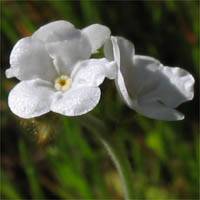Rusty popcornflower facts for kids
Quick facts for kids Rusty popcornflower |
|
|---|---|
 |
|
| Scientific classification | |
| Genus: |
Plagiobothrys
|
| Species: |
nothofulvus
|
The Plagiobothrys nothofulvus is a type of flowering plant. People often call it the rusty popcornflower or foothill snowdrops. This plant grows naturally in western North America. You can find it from Washington and California all the way down to northern Mexico. It is a spring wildflower. It likes to grow in grassy meadows, forests, coastal sage scrub, and wet areas near rivers.
Contents
What is the Rusty Popcornflower?
This plant is an annual herb. This means it lives for only one year. It grows straight up, usually between 20 and 70 centimeters tall. That's about the height of a ruler or two!
The plant has purple sap inside. Its edges are often purple or rusty red. If you crush it, purple liquid might come out. The plant feels hairy and rough. Most of its leaves grow in a circle around the bottom of the stem. A few leaves are spaced out along the stem.
The flowers grow in a group called an inflorescence. Each flower is tiny, only 3 to 9 millimeters wide. They are white and have five small parts. After the flowers, the plant makes a small, round fruit called a nutlet. It has a pointed tip and is about 2 millimeters long. These nutlets often grow in groups of one, two, or three. The plant has deep roots, especially in dry soil.
Where Does the Rusty Popcornflower Grow?
The rusty popcornflower is native to parts of the Pacific Northwest. It grows from northern California up into southern Washington. Some plants have been found as far south as Baja California, Mexico. Others are found north near the Columbia River Gorge.
Where Does the Rusty Popcornflower Live?
This plant loves grassy meadows. It especially likes those found along the coast. You can also find it in woodlands and areas with coastal sage scrub. It grows in wet places near rivers too. The rusty popcornflower often grows in special types of soil. These are called serpentine or plutonic soils.
Other plants often grow near the rusty popcornflower. These include Aster chilensis, Lotus angustissimus, and Brodiaea terrestris.
How Does the Rusty Popcornflower Interact with Animals?
The rusty popcornflower is a food source for many animals. Deer, ground squirrels, and different insects eat the plant. Turtles also munch on its flowers in wet areas. Black seed-harvesting ants like to eat the plant's seeds.
Some types of beetles use the flowers as a place to lay their eggs. Butterflies, moths, and bees drink the sweet nectar from the flowers. While they drink, they help pollinate the plant. Ctenuchid moths are often seen on these flowers. Scientists are still learning about how important these moths are to the plant.
Reproduction and Life Cycle
The flowers of the rusty popcornflower usually bloom from February to April. Like many plants in its family, each flower has five petals. The flowers are bisexual. This means they have both male and female parts.
Bees and butterflies are the main pollinators. They carry tiny pollen grains (which are like male plant cells) from one flower to another. The pollen lands on the pistil, which is the female part of the flower. Then, the pollen travels down the pistil to the ovule. Inside the ovule is the egg, or female plant cell.
Each pollen grain has two sperm cells. These are used for a special process called double fertilization. One sperm cell joins with the egg to form a zygote. This zygote will grow into a new plant. The other sperm cell helps form the endosperm. The endosperm is like food for the new seed as it grows.
Protecting the Rusty Popcornflower
The rusty popcornflower is an endangered species in Oregon. This means it is at risk of disappearing forever. The biggest threat to this plant is habitat loss. Many areas where it used to grow have been turned into farms.
Other dangers include the loss of seasonal wetlands. This happens because of habitat damage and changes in the climate. Also, invasive species (plants that are not native and grow too much) are a big problem.
People are working to protect the rusty popcornflower. They are setting up protected areas for the plants. They are also saving seeds. Education is important too, so landowners learn how to help. Restoring the plant's natural habitats is another key effort.

